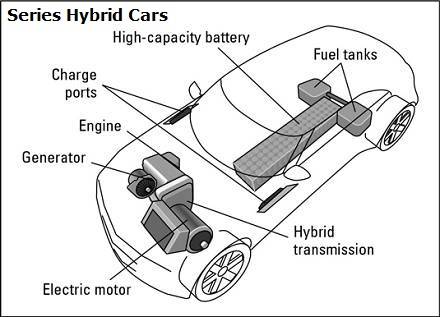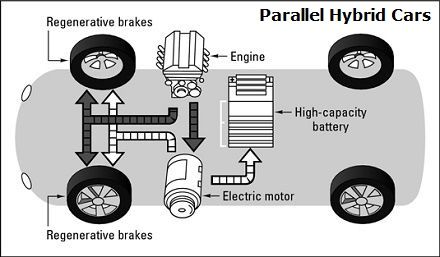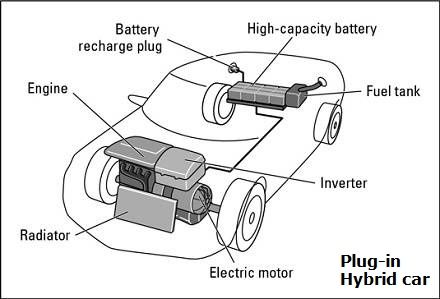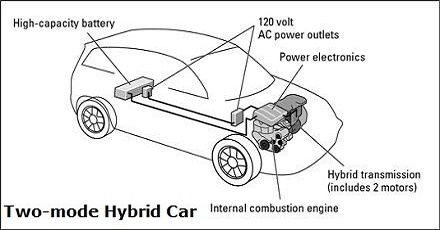4x4 Off Roading ›› Sport Utility Vehicles ›› Hybrid Cars
Key Facts about Hybrid Cars
What is a Hybrid Car? In simple terms, hybrids are vehicles which achieve maximum power and fuel economy by using multiple, and different, classes of on-board energy systems.
Therefore, typically a hybrid vehicle comprises one or more electric motors (with battery packs) as well as a small size traditional internal-combustion engine (ICE) and a fuel tank.
Hybrid Cars Pros and Cons
Hybrid cars have several advantages over traditional petrol-driven or diesel vehicles. Perhaps the most significant benefit is being a money-saver (in the long run).
When hybrids combine an electric motor with a gasoline internal combustion engine, all other things being equal, they deliver significantly higher fuel efficiency than traditional gasoline-powered cars.
There is also a strong argument that no matter how you evaluate hybrid cars pros and cons - better or worse - hybrids clearly deliver minimum emissions into the environment.
How Do Hybrid Cars Work?
The way hybrid cars deliver better fuel economy and save money varies by model, and to a certain extent, with varying success rates.
Nevertheless, all hybrids have an ability to generate electric current and store this energy in a large battery unit. Therefore, the current produced helps to provide propulsion and power for the vehicle.
Regenerative Braking Systems
Most hybrid engines can power a generator and the regenerative braking system captures energy and converts it into further electrical energy.
Hybrids conserve energy by shutting down the internal combustion engine (ICE) during times when the vehicle is idling at a light or stopped in traffic (such as in Park mode).
They also benefit from the electric motor's energy any time the vehicle can be driven without assistance from the alternative engine.
Hybrids' regenerative braking systems generate electric power to help charge the battery packs. The vehicle's electric motor operates as a generator and when the driver applies the brakes, the magnetic drag slows the vehicle down.
The standard hydraulic braking system stops the car any time the regenerative braking is insufficient, for safety.
In fact, when you consider the pros and cons of hybrid cars, there really is no difference in maintenance or repair for the braking systems except that the pads tend to last longer because they get used less in hybrids.
It is true that you rarely use the disc brakes on the wheels if you drive a hybrid moderately. In actuality, the original brake pads may last the life cycle of the car.
Series Hybrid Cars


The fact that a series hybrid uses a gasoline or diesel internal combustion engine coupled with a generator (to generate electricity - not to drive the car) means that the engine can send the electric current directly to the electric motor.
Another plus point is that it also charges a large battery, storing electricity and delivering it to an electric motor when required.
The motor uses the stored electricity to propel the vehicle. It does so by powering and rotating the driveshaft (or drive axles) which turns the car's wheels.
Parallel Hybrid Vehicles
Propulsion is provided for a parallel hybrid car by an electric motor and an internal combustion engine. Both engines can run in tandem which is the principle advantage of parallel hybrid cars.
Nevertheless, when extra power is called for, one engine can be used as the primary power source with the other assisting, such as when climbing steep hills.
Pro Tip: They are said to run in 'parallel' because both engines are in fact connected to the drive train.
Plug-in Hybrid Vehicles
 The main pros and cons of hybrid cars with plug-in systems is that they feature large batteries which charge to capacity at any regular 110-volt electrical socket.
The main pros and cons of hybrid cars with plug-in systems is that they feature large batteries which charge to capacity at any regular 110-volt electrical socket.
This means they have the capacity to extend the ability of the electric motor to drive the car farther without the need for starting the combustion engine and therefore substantially increasing the fuel efficiency of the car.
Conservative estimates have ranged this statistic as high as 100 mpg.
The development of new, smaller, high-capacity lithium-ion batteries is the key to making plug-in hybrids available to the general public, mainly because the batteries can be recharged many times over.
Reported estimates suggest that plug-in hybrids equipped with these extremely powerful batteries will have a range around 125 miles before the charge is depleted and the vehicle reverts to standard hybrid mode.
The core environmental problem with plug-in hybrid vehicles is that the electric current they draw is usually generated by utility companies which are powered by fossil fuels.
Nonetheless, better news is that some major chains have committed to establishing charging stations powered by solar panels or wind energy.
There is also evidence that many hybrid owners are willing to install solar panels to recharge these vehicles at home.
Plug-in hybrids charged by commercial sources of electricity or solar panels will be less dependent on the internal combustion engine, but will still need it for longer journeys.
The hope is that future hybrids will use a small fuel cell to make electricity from hydrogen, meaning that the alternative engine would need to be used less.
Two-mode Hybrid Cars
 There are suggestions that two-mode hybrid cars may be the best option for the United States to acquire a worthy competitive place in the hybrid market.
There are suggestions that two-mode hybrid cars may be the best option for the United States to acquire a worthy competitive place in the hybrid market.
Typically, two-mode hybrids use smaller batteries and two electric motors located inside an automatic transmission with two sets of gears instead of the large storage battery found on conventional hybrids.
One motor is used for the internal combustion engine and the other's role is to amplify the power of the electric one.
The car's transmission functions as a continuously variable transmission. At lower speeds, the car runs with one or both electric motors alone (with or without the ICE).
When the car utilizes the second mode the combustion engine runs continuously in its higher gear ratios which is most advantageous at higher speeds.
You might also enjoy reading about...
The answer to the question "what car is the best 4x4 hybrid in the UK 2025" is one that stimulated a lot of cool responses. Check out the blog post and see if you agree with our pick of the top 5 hybrids for sale in the United Kingdom.
Plus, another section explores the current Chinese car brands in the United Kingdom that offer consumers a wide range of choices with lower prices.